Mexico City, 1960s: Father Carlos Mora, LC, carrying out his apostolate with some young students.
Beginnings of the Regnum Christi Movement
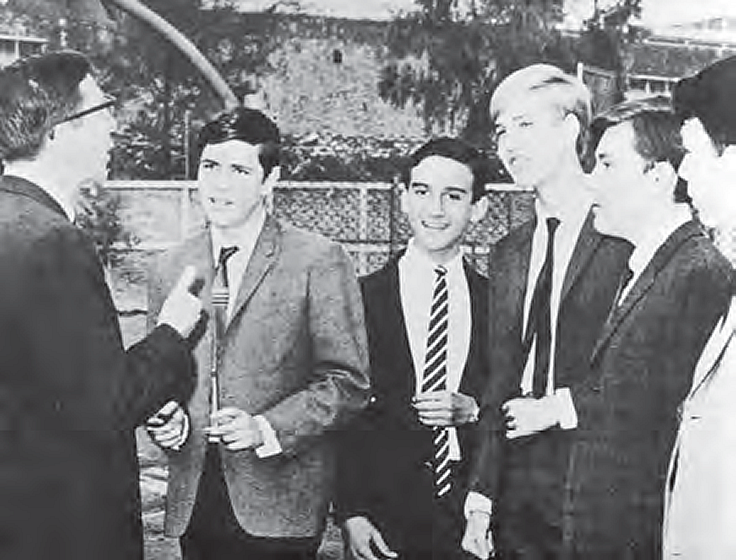

Madrid, 1968: Father Alfredo Torres, LC, with the first Spanish members of Regnum Christi.

Madrid, 1968: First members of Regnum Christi during a film forum.
1950s and 1960s
Organization of lay people who collaborate in the establishment of the Kingdom of Christ.
Today, Regnum Christi is an ecclesial movement of apostolate. A long historical journey, beginning in the 1940s, has led to this result. In the Nihil obstat granted to the Legion in 1948 by the Congregation for Religious, there was reference to a form of collaboration with the Catholic laity by the nascent Institute: one of the stated purposes was to assist Catholic Action.
The text of the 1948 Constitutions was even more explicit: “The specific purpose of the institute is the creation of special organizations of lay people who collaborate unconditionally in the establishment of the Kingdom of Christ according to the demands of Christian justice and truth.” It also stated that the task of these organizations was to work so that “not only men profess a complete Christianity, but that society itself is governed and behaves in a Christian manner.”
In the 1950s, the Legionaries of Christ thought of this project as a “second Legion,” but it was too early to put that idea into practice. The final part of a promotional video from 1952 prepared by the community at the College in Rome declared that the seminarians living there were preparing to carry out their concrete apostolate among the laity once they had become priests. In fact, this is what happened. By the early 1960s, the Legion of Christ had already opened some schools, which allowed them to intensify work with laypeople.
In this regard, in March 1963, the Inter-American Cultural Center was inaugurated in Mexico City, and simultaneously, some student groups with various names were born: Milites Christi, Crusaders of Christ the King, Perficit Groups, in which the content of the evangelical message was discussed and assimilated. However, these groups did not continue and were dissolved. Still, in 1963, the definitive name for the new lay organization was chosen. Likely using an expression from the original text of the Legion’s Constitutions, written in Latin, it would be called Regnum Christi. In the following years, the Congregation persevered in the effort and began to develop a more organized action among the laity.
Furthermore, the Second Vatican Council itself had reminded all Christians of their vocation to holiness and apostolate. In the Decree Apostolicam Actuositatem of November 18, 1965, it was written:
“Our times do not require less zeal from the laity, but, on the contrary, the current circumstances demand a much more intense and broader apostolate. Because the number of men, which increases daily, the progress of science and technology, and the closer relationships between men, not only have extended to infinity the vast fields of the laity’s apostolate, partially open only to them, but also have raised new problems that require their diligent care and attention.”
It also illustrated the nature, character, and variety of the apostolate of the laity, outlining “the fundamental principles” and providing “pastoral instructions for their greater effectiveness.”
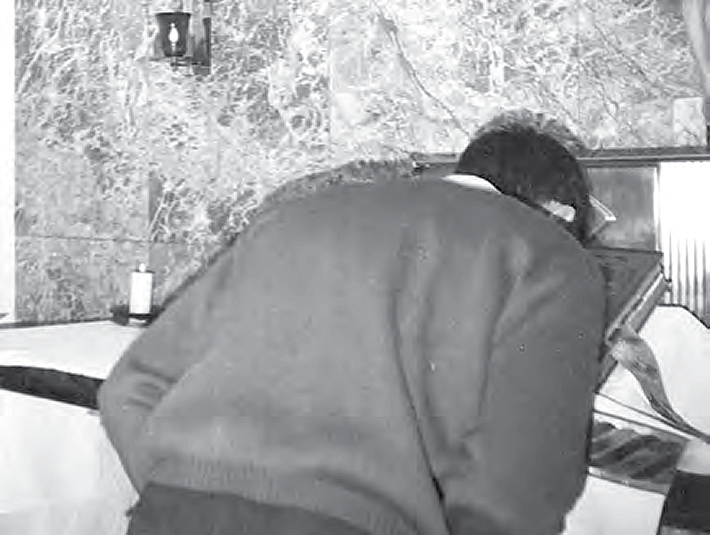
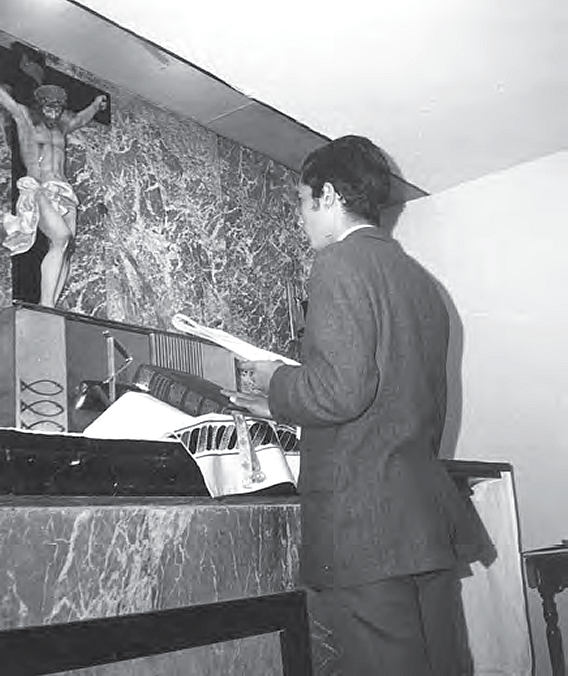
Mexico City, Inter-American Cultural Center, 1969: Moment of the first incorporation into the Regnum Christi Movement in Mexico.
First Incorporations in 1968
The definitive attempt came when, in 1965, a small Legionary community settled in Madrid. Three years of continuous work among the youth of the Spanish capital led to the first incorporation into Regnum Christi. This incorporation took place at the Basilica of Our Lady of the Pillar in Zaragoza on January 3, 1968. A simple account of the event can be found in the May 1969 issue of Forja magazine. In it, the young people from Madrid shared their experience:
“As you know, Zaragoza is the center of all Marian pilgrimage in Spain; and there, a few of us went to present before Her our desires to remain faithful to the cause of Her Son. Our presentation to the Virgin was made by Father Alfredo in a very emotional act for us, after a Mass celebrated at the altar of the Pillar, as the people of Zaragoza affectionately call their Virgin. The journey there, and especially the return trip to Madrid after having fulfilled our purpose, was filled with great joy. This guest of honor is always present at our common events!”
This was the first written testimony by the members of the Regnum Christi Movement. A few months after the first incorporation, this group of young people went to Rome and, among other activities, participated in an ecclesiology seminar titled “Know the Church.”
This was the first formation course of Regnum Christi. In the aforementioned Forja magazine, these young people wrote that their ideal was:
“To live and make others live an integral Christianity: (…) What do we, the university youth of the Madrid Front, do? Nothing more, nothing less than that: to live as Christians and to Christianize our environment, with the testimony of a life constantly illuminated and encouraged by God’s grace.”
After the incorporation of the Spanish youth, the first incorporations of some young Mexicans took place in 1969. Finally, the lay part of Regnum Christi existed concretely, and from being just a project, it had become a reality.
1968 – 2004
Regnum Christi from 1968 to 2004
Late 1969 – The First Institutional Text
At the end of 1969, the first institutional text was released, primarily the result of intense formation courses conducted by Legionary religious in Mexico. This initial version of the Manual of Regnum Christi indicated that the nature of the new ecclesial entity was precisely that of a Movement and contained its basic principles.
The functional structure was based on cells, teams, groups, and networks; the internal structure, on the other hand, was made up of sympathizers and members of the first, second, and third degrees. In December 1971, a new version of the Manual was released, which expanded and systematized the 1969 version. It detailed the definition, structure, spirit, and fundamental lines of Regnum Christi. It also identified the main apostolic actions that the movement would undertake. In particular, the principles of personal, one-on-one action and teamwork, conceived as a true “small church,” were outlined.
Additionally, all the activities aimed at the formation of members were described. These activities included study circles, Encounters with Christ, renewal days, and retreats. Meanwhile, in 1971, the Legionaries of Christ community in Rome held an important seminar that produced the Vocabulario del Regnum Christi. This text deepened the disciplinary, doctrinal, and methodological aspects of the movement. Internally, the organization was entrusted to private statutes, the first draft of which was created in 1979.
The 1980s
The Statutes regulated the conditions of admission and the exercise of authority: at the head of Regnum Christi was a general director, a term that from 1980 onwards was also used by the Legionaries to refer to their superior general. The path was set, and Regnum Christi could now grow. The international character of the movement quickly took shape, and by 1976, active sections were established in Ireland, Spain, Italy, the United States, and Mexico. According to the chapter fathers of the Legion of Christ, by 1980, Regnum Christi was presented as “an organic, dynamic, compact, and well-structured body that, with its methodology both flexible and well-defined, and with its solid pedagogy, is called to grow, multiply, and develop, like the evangelical seed, across the vast field of the world and society into a new humanity redeemed by Christ and shaped according to the message of the Gospel.”
In addition to growing (by 1985, there were 11,122 members, including youth, adults, and children from ECyD), Regnum Christi had consolidated over the years.
On March 30, 1985, it collaborated for the first time with the Pontifical Council for the Laity, organizing a penitential vigil in Spanish at the Basilica of Santa Maria Maggiore in Rome. This vigil was presided over by Cardinal Eduardo Pironio and was held in preparation for the First World Youth Day with Pope John Paul II. During the following General Audience on April 3, the Pope responded to the enthusiasm of the movement’s members present. It was the second time the Pope had directly greeted Regnum Christi, as on January 2 of that same year, he had publicly greeted a group of consecrated women. During his pontificate, Pope John Paul II frequently addressed the Legionaries and members of the movement with the expression: “It is seen, it is felt, Regnum Christi is present.” In the following years, Regnum Christi consistently participated with its own representative at the Youth Forum held during World Youth Day. The maturation of the movement also led to an update of its institutional texts: in 1988, a new version of the private Statutes was published, and in 1990, the Manual was updated.
The 1990s
“The hour of Regnum Christi has come” – with this decisive phrase, the communiqué of the 1992 General Chapter introduced its reflections on the movement.
In 1998, Pope John Paul II emphasized the importance of new movements born within the Church during the 20th century at the World Congress themed “Ecclesial Movements: Communion and Mission at the Threshold of the Third Millennium.” In the message to participants, the Holy Father wrote:
“What is understood today by ‘movement’? The term often refers to realities that differ from one another, sometimes even in their canonical configuration. If, on the one hand, this cannot certainly exhaust or fix the richness of the forms brought about by the life-giving creativity of the Spirit of Christ, on the other hand, it refers to a concrete ecclesial reality in which laypeople participate primarily, a journey of faith and Christian witness that bases its pedagogical method on a precise charism.” He added: “Movements can thus make a valuable contribution to the vital dynamics of the one Church, founded on Peter, in diverse local situations, especially in regions where the implantation of the Church is still in its early stages or faces many difficulties.”
Approval of the Statutes in 2004
An important further step for Regnum Christi was the approval of its statutes in 2004, an act directly carried out by Pope John Paul II, made public through a decree signed by Cardinal Franc Rodé, CM, then prefect of the Congregation for Institutes of Consecrated Life and Societies of Apostolic Life. This document affirmed that “the work carried out by the Legionaries of Christ and the members of the Regnum Christi apostolic movement in building the civilization of Christian justice and love is well-known.”

Madrid, 1970s: members of Regnum Christi in a meeting.
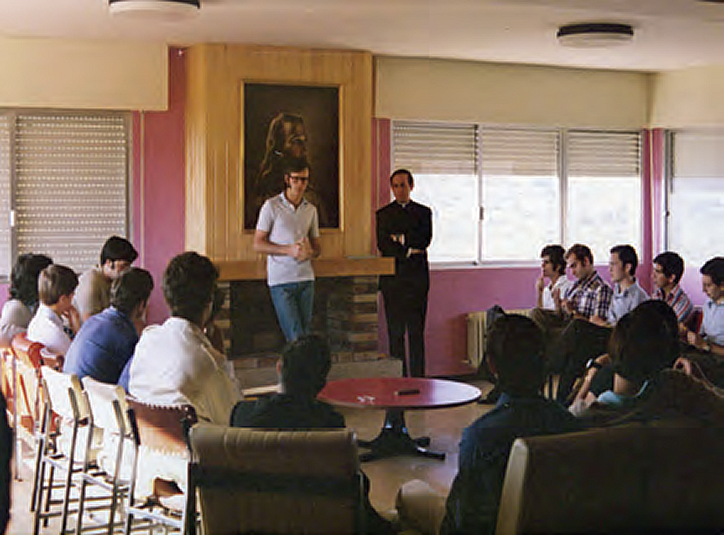
Spain, Reajo del Roble, 1974: a moment from a Regnum Christi Cursillo.

Mexico, 1981: Fr. Jesús Blázquez, LC, with the members of the first Regnum Christi team in Aguascalientes.
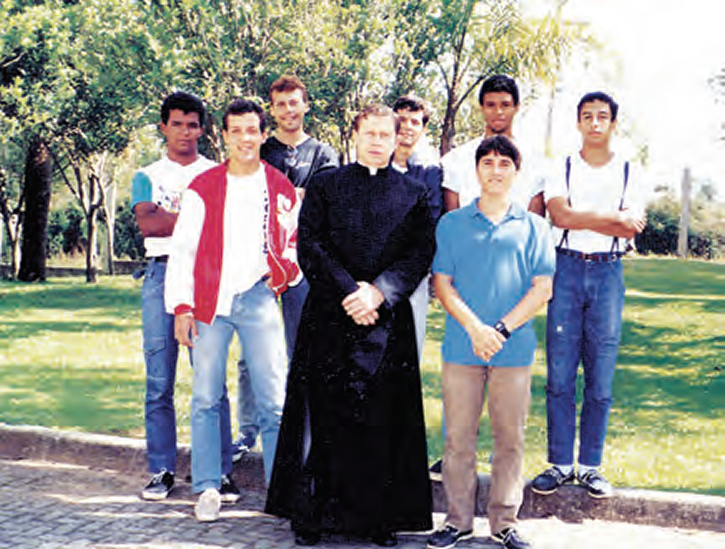
Brazil, 1986: a group of young members of Regnum Christi accompanied by Fr. Eduardo Robles-Gil, LC.
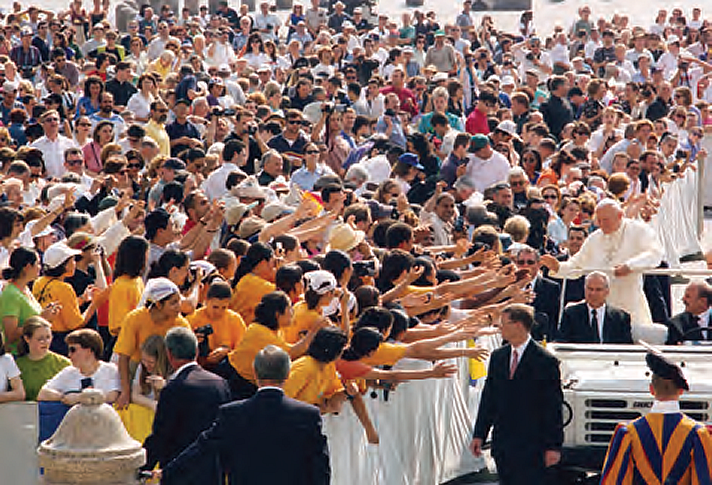
Vatican, St. Peter’s Square, May 30, 1998: some young members of Regnum Christi greeting Saint John Paul II.
This section has been taken from the publication «Historia Institucional de la Congregación de los Legionarios de Cristo y del Movimiento Regnum Christi» (2015), prepared by the General Historical Archive of the Legion of Christ and Regnum Christi and published on the occasion of the 75th anniversary of the Congregation. Published in Spanish and Italian.
Texts: Salvatore Luciano Bonventre | Translations: Fr. Gonzalo Franco, LC | Selection of photographs: Salvatore Luciano Bonventre and Luigi Baldassarri | Coordination: Fr. Jaime Rodríguez, LC and Fr. Rodrigo Ramírez, LC


